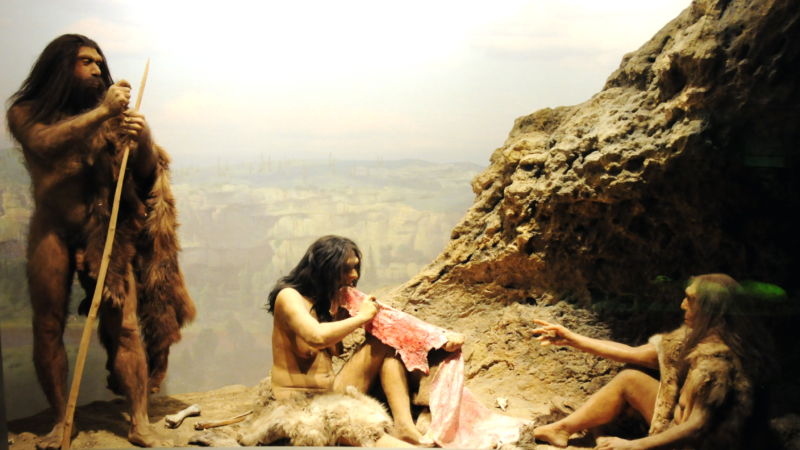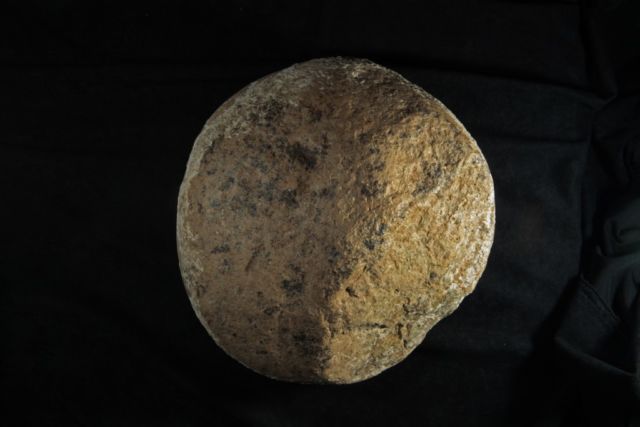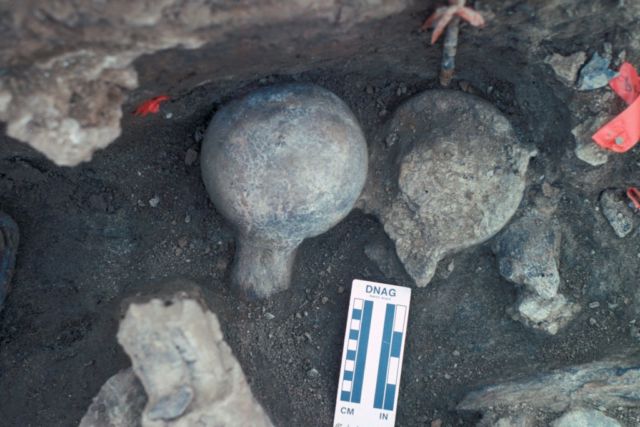
Last year, archaeologists in California made a startling announcement: they had discovered a 130,000 year-old prehistoric human campsite in the Golden State. According to currently accepted evidence, the first modern humans were just venturing out of Africa at that time, and no one would set foot in the Americas for about 115,000 years. Not surprisingly, the claim met with skepticism from other archaeologists, who said that the evidence at the site wasn’t enough to support rewriting the entire story of human migration.
That evidence is a collection of broken mastodon bones, rounded cobbles, and flat stones. These bits and pieces were unearthed during a 1992 highway construction project in San Diego and are now known as the Cerutti Mastodon Site. Archaeologist Steven R. Holen of the San Diego Natural History Museum and his colleagues say that early humans used the cobbles as hammers and the flat stones as anvils to crack open mastodon bones to get the marrow inside. They say the Cerutti site represents a very early wave of human migration into the Americas, perhaps one that didn’t last long enough to get a foothold. That explains why no other human campsites this old have turned up in the Americas.
There’s no question about the age of the site. Radiometric testing relying on uranium decay and several other methods put the bones at over 100,000 years old, and even critics agree that the dating is reliable. The debate centers on whether the items at Cerutti are really proof of human activity, and competing arguments have been published in today’s issue of Nature.
“There are still significant issues with the evidence of the Cerutti Mastodon archaeology site, in particular with the taphonomic processes of the site,” said archaeologist Daniel Rafuse of Trent University, commenting on the debate.
Leaving no stone unturned
Part of the problem is that if the stones found at Cerutti are actually tools, they’re among the simplest types—the kind people just pick up off the ground and use without chipping or flaking them into obviously recognizable shapes like hand-axes or spear points. That can make it difficult to tell a cobble that’s been knocked around a bit from a cobble that someone once used as a hammer.
“The only tools needed to break these bones, based on experimental archaeology breakage of elephant limb bones, are cobble anvils and hammers. We state that there is no evidence that humans hunted/killed or butchered the mastodon, so you would not need chipped stone tools,” said Holen. “At the Cerutti Site, the mastodon bone was apparently scavenged from a mastodon that was already dead.”
Holen and his colleagues say that the breaks and chips on the cobbles look exactly like what you’d expect if the cobbles had been pounded against a stone anvil. The flakes broken off by the impact even still fit perfectly into their old spots on the stone hammers. But Ferraro and his colleagues contend that, although the marks on the stones certainly could have been the work of humans banging the stones together, they could also have been the product of natural forces, like stones knocking together as they washed downstream during a flood.
If Ferraro and his colleagues are right, that doesn’t rule out human activity, but it means there could be other explanations. And that’s important because it would mean we can’t be sure that this site is the big deal that Holen and his colleagues claim it is.
“We urge caution in interpreting the current record,” wrote Ferraro and his colleagues. “The extraordinary claim by Holen et al. of prehistoric hominin involvement at the [Cerutti Mastodon] site should not be contingent on evidence that is open to multiple, contrasting interpretations.”

Bones of contention
Another key debate centers on how the mastodon bones at Cerutti got broken: were they crushed beneath accumulated layers of dirt, or did humans do it? Holen and his colleagues say the damage to the bones is clearly human handiwork. They even made their own set of similar stone hammers and anvils, then smashed some elephant bones with them. The resulting damage matched the fractures on the mastodon bones at Cerutti, and the archaeologists say none of their other experiments managed to produce that set of fractures.
But Baylor University anthropologist Joseph Ferraro and his colleagues argue that natural processes could also have been to blame. They say they’ve seen the same kinds of spiral fractures, impact notches, and flake scars on bones at other sites—like a group of 24,000-year-old mammoth bones at Inglewood Mammoth Site in Maryland, a group of 66,800-to-51,300-year-old mammoth bones at Waco Mammoth National Monument in Texas, and others dating all the way back to the Triassic Period.
No one has ever even suggested human occupation at these sites. Instead, the fractures turned out to be the result of postmortem trampling by other mammoths, the weight of several meters of sediment, or heavy earth-moving equipment. And at many of those sites, paleontologists found stone cobbles similar to those at Cerutti.
Holen and his colleagues maintain that the bones at Waco Mammoth National Monument actually show a different kind of fracture, which happens long after death when bones are dry. Fresh fractures, they say, produce smoother surfaces like those on the Cerutti Mastodon bones. And the notches in the bones at other sites are shallower than those at Cerutti, whose depth indicates deliberate human activity rather than natural wear and tear.

Meanwhile, Ferraro and his colleagues say that the Cerutti bones are missing other kinds of fractures, which should be on at least some of the bones if humans really broke them—a type of damage called “hammerstone striae” or “hammerstone pits.” (Archaeologists know this, again, from time spent making stone tools and then smashing elephant bones with them.)
San Diego Natural History Museum archaeologist Thomas A. Deméré counters that at least one bone fragment from Cerutti did show hammerstone striae, and much of the mammoth’s skeleton was missing from the site. And while experimental archaeology tells researchers to expect these features in the damage caused by hafted stone hammers, the Cerutti Mastodon tools would have been handheld and might show different patterns.
And Holen and his colleagues offer another piece of evidence. A crust of a substance called pedogenic carbonate—which precipitates out of certain kinds of soil as they form—was found around most of the bones and stones at Cerutti. Because the crust appears to have formed around the broken bones and the crust isn’t broken, the bones must have been broken before the crust formed, the archaeologists say.
“Therefore, these features, as well as the clustered distributions of [Cerutti Mastodon] bones and stones, could not have been the result of more recent events like heavy equipment or even sediment compaction,” Deméré explained.
More evidence needed
The debate over Holen and his colleagues’ extraordinary claim is far from settled, and in fact, it seems to be getting pretty heated.
“We have never felt that this one site would represent a paradigm shift. We are in the field at present looking for additional sites of this age,” Holen told Ars Technica. “The answer to the question of when humans first arrived in the Americas requires people to do a lot of fieldwork and to have an open mind about human capabilities.”
At the moment, there’s no clear evidence that the stuff at Cerutti wasn’t the work of humans who got here way before everyone else. But there’s also not nearly enough evidence to say that they were, given that there are other explanations that don’t require such a big leap.
“The taphonomic issues must continue to be carefully deliberated. More converging evidence is needed in order to overturn the current scientific consensus of the timeline of human dispersal into the Americas,” said Rafuse.
Nature, 2017. DOI: 10.1038/nature22065 (About DOIs).
https://arstechnica.com/?p=1255837

